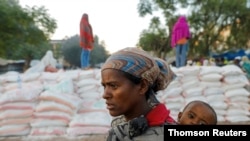The International Rescue Committee said Thursday that a bridge that provides one of the main supply routes into Ethiopia’s Tigray region has been destroyed.
“Tekeze Bridge — one of the main supply routes into Tigray, Ethiopia — has been destroyed,” the IRC said in a tweet. “This means aid efforts will be even more severely hampered amid the ongoing conflict. The IRC continues to call for unfettered humanitarian access to the region.”
USAID administrator Samantha Power said of the four routes into Tigray, only one may now be usable.
A U.N. spokesperson said the organization was aware of the report about Tekeze Bridge, but did not have any firsthand information on its status.
“We're trying to get our people in [to Tigray], we're trying to get other agencies in to help the people,” U.N. spokesperson Eri Kaneko said in response to reporters’ questions. “And if the reports are confirmed of this bridge being severely damaged, that would be yet another setback to our efforts to help the people of the region.”
About 6 million people live in Ethiopia’s northern Tigray region. The United Nations says more than 5 million of them are in need of emergency food assistance. Another 350,000 are coping with faminelike conditions because of eight months of fighting.
On Tuesday, USAID official Sarah Charles told U.S. lawmakers that the number of people in faminelike conditions is closer to 1 million, and warned that without scaled-up aid deliveries, “we will likely see widespread famine in Ethiopia this year.”
Ethiopia suffered a devastating famine in the early 1980s that affected millions and killed more than a million people.
Tenuous calm
The U.N. spokesperson said the situation Thursday in Tigray “remains volatile and unpredictable,” just days after the Ethiopian federal government declared it was pausing its military operation there.
The spokesperson said major towns, including Mekelle, Adigrat, Adwa, Axum and Shire, were calm, but that there are unconfirmed reports of clashes in the southern and northwestern zones.
“Electricity and telecommunications are still cut off throughout the region,” said Kaneko, the U.N. spokesperson. “There are no flights or road transportation in or out of the region.” She said the U.N. and its partners are assessing access along main roads so they can resume aid deliveries.
But despite the continuing challenges, some limited assistance has gotten through.
On Wednesday, humanitarians were able to transport fuel for water pumps, firewood for cooking, and water to sites assisting displaced persons in the regional capital, Mekelle. Water was also distributed to the displaced in Shire, and medical services were provided in Samre town.
The Ethiopian government announced the unilateral cease-fire on state media late Monday, saying it would take effect immediately, after nearly eight months of conflict.
Analysts said the timing was likely because of a combination of successes by the rebels on the battlefield and Western pressure to halt the fighting to avoid a famine.
Since the Ethiopia National Defense Force withdrew from Mekelle, the city remains under the full control of the Tigray Defense Forces. The U.N. said that is also the case in Adigrat, Adwa, Axum and Shire.
But it is not certain the calm will hold.
Marina Ottaway, a political scientist with the Woodrow Wilson International Center for Scholars based in Washington, said this week she did not think the unilateral cease-fire would be the end of the fighting.
“I think the Ethiopians will try to maintain the cease-fire, but the Tigrayans are not interested at this point,” she said.
The U.N. Security Council is likely to discuss developments in Tigray on Friday afternoon after receiving a request from several council members.
“I’m pretty confident it will take place,” said France’s U.N. Ambassador Nicolas de Riviere, who took over the council presidency for July on Thursday.
He told reporters that the council would receive political and humanitarian briefings and he had encouraged the Ethiopian ambassador to address the meeting, which he expects to be public.
Fighting between the Ethiopian federal government and the Tigray People’s Liberation Front (TPLF) broke out in November, leaving thousands of civilians dead and forcing more than 2 million people from their homes. Troops from Eritrea, Ethiopia’s neighbor to the north, and Amhara, a neighboring region to the south of Tigray, also entered the conflict in support of the Ethiopian government.









